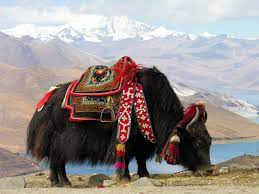Domestic Yak
2021 JUL 14
Preliminary >
Environment and Ecology > Species extinction & protection > Species in news

Why in news?
- For the first time, National Insurance Company Ltd (NICL) has decided to insure the highly valuable Himalayan cattle.
- Yaks are susceptible to inclement weather conditions due to climate change, diseases, attacks by wild animals, etc.
About Domestic Yak:
- The domestic yak (Bos grunniens) is a long-haired domesticated cattle found throughout the Himalayan region of the Indian subcontinent, the Tibetan Plateau, Northern Myanmar, Yunnan, Sichuan and as far north as Mongolia and Siberia
- It is descended from the wild yak (Bos mutus).
- Yaks are heavily built animals with bulky frames, sturdy legs, rounded, cloven hooves, and extremely dense, long fur that hangs down lower than the belly.
- While wild yaks are generally dark, blackish to brown in colouration, domestic yaks can be quite variable in colour, often having patches of rusty brown and cream.
- Male Yaks weigh 350 to 585 kg and females weigh 225 to 255 kg.
- Both sexes have long shaggy hair with a dense woolly undercoat over the chest, flanks, and thighs to insulate them from the cold.
- Yak physiology is well adapted to high altitudes, having larger lungs and heart than cattle found at lower altitudes, as well as greater capacity for transporting oxygen through their blood due to the persistence of foetal haemoglobin throughout life.
- Further adaptations to the cold include a thick layer of subcutaneous fat, and an almost complete lack of functional sweat glands.
- Conversely, yaks have trouble thriving at lower altitudes and are prone to suffering from heat exhaustion above about 15 °C.
- Compared with domestic cattle, the rumen of yaks is unusually large, which allows them to consume greater quantities of low-quality food at a time, and to ferment it longer so as to extract more nutrients.
- The animal is a lifeline for pastoral nomads living in the higher reaches of the Himalayas where other bovines will not survive or at least, not without difficulty.
Prelims Question
Consider the following statements regarding Domestic Yak:
1.They can survive in both hot and cold climates easily.
2.They are found only in Tibetan Plateau and Himalayan regions.
Which of the statements given above is/are correct?
(a)1 only
(b)2 only
(c)Both 1 and 2
(d)Neither 1 nor 2
Answer to prelims question
